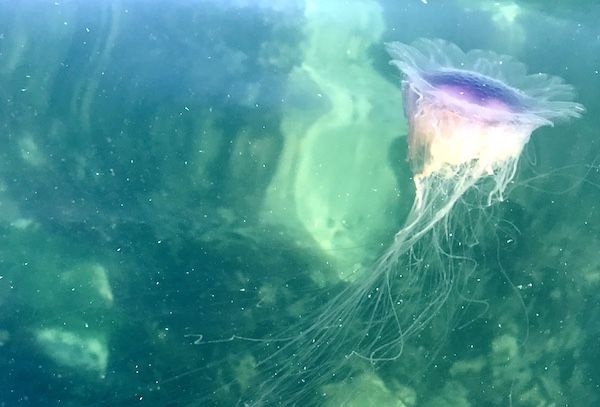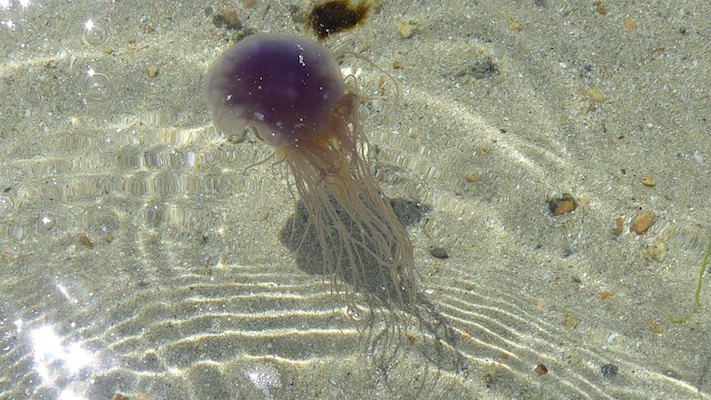

A number of reports of jellyfish present in local waters have been made over the last week, with sightings including clear, blue and purple coloured specimens of the marine animal.
A spokesperson for the States said reports of jellyfish sightings normally coincided with a period of hot weather and while many are inocuous - giving just a light sting - people should not touch them and are advised to avoid them if possible.
Last weekend sightings were reported at Fermain, Rousse, Pembroke, Houmet, St Sampsons Harbour, Belvoir and many other beaches around Herm.
Ray Tubby saw lots of jellyfish on the North beach in Herm and said: "There were loads of them it was like a jellyfish soup in the water. It is a shame that we have to watch out for weaver fish on the low tide and jellyfish on the high tide."
Mr Tubby took a photo as he agreed the animals were stunning: "They are pretty to look at, but they are a nuisance for swimming. There certainly seems to be more coming to our waters over the last two or three years. There were shoals of them about on the weekend."

Pictured: Photo by Ray Tubby of one of the jellyfish on Herm 23 June 2018
A spokesperson for Agriculture, Countryside and Land Management Services (ACLMS) said that jellyfish had been reported recently. "The species has not been confirmed but the description provided indicates the jellyfish seen are likely to be Blue Jellyfish Cyanea lamarkii. This species can grow to approximately 30cm and has a bell shaped body through which blue radial lines can be seen."
"Many species of jellyfish are largely harmless and are often attractive but should not be touched if people come across any in the sea or on the beach. It is rare for the poisonous Portuguese Man-of-War, distinguished by its blue air-filled ‘fin’, to be found on Guernsey."
Richard Lord who specialises in marine identification added: "The Portuguese man-of-war is not actually a jellyfish but is a marine hydrozoan."
Mr Lord added that there are a large number of marine wildlife in local waters that look like jellyfish, but are not. "The photo below shows a ctenophore or comb jelly, which has no sting, it is a very delicate creature and breaks up quite easily. Whilst most creatures in our waters will not sting or will only give a mild sting it is not recommended to handle any for safety and also younger people and those with sensitive skin may have different reactions."
Mr Lord said that the 'Guernsey Wildlife' Facebook page welcomed any sightings and pictures of marine animals and there was a good team of individuals who could help identify species.
Pictured: Photo courtesy of Sanne Schouwenburg. This is a Comb Jelly, not a jellyfish.
This blue variety of jellyfish can look a different colour in different lights and the variations in colour from blue to purple are said to be because of the age of the creatures. Commentators on the Guernsey Wildlife Facebook page stated that stings for most people would be no worse than a nettle sting.
The ACLMS spokesperson continued: "As a precaution we advise that beachgoers do not touch any jellyfish they may find on the beach. People are recommended to seek the advice of their GP or pharmacist if they are concerned after being stung by jellyfish. However, dial 999 if anyone has severe symptoms, such as difficulty breathing or chest pain, or if a large or sensitive area of the body has been stung."
More information on the jellyfish species found around the British Isles can be found on the Marine Conservation Society’s website which has a species identification guide.
Click on the below image to see the full PDF identification guide.
Reports and photographs of jellyfish seen on Guernsey beaches are welcomed by the Marine Conservation Society and ACLMS said: "We’re always glad to receive reports of jellyfish and where they’re found, people can send information to aclms@gov.gg"
Pictured: Jellyfish at Fermain on 22 June 2018 picture courtesy of Sanne Schouwenburg.
Comments
Comments on this story express the views of the commentator only, not Bailiwick Publishing. We are unable to guarantee the accuracy of any of those comments.